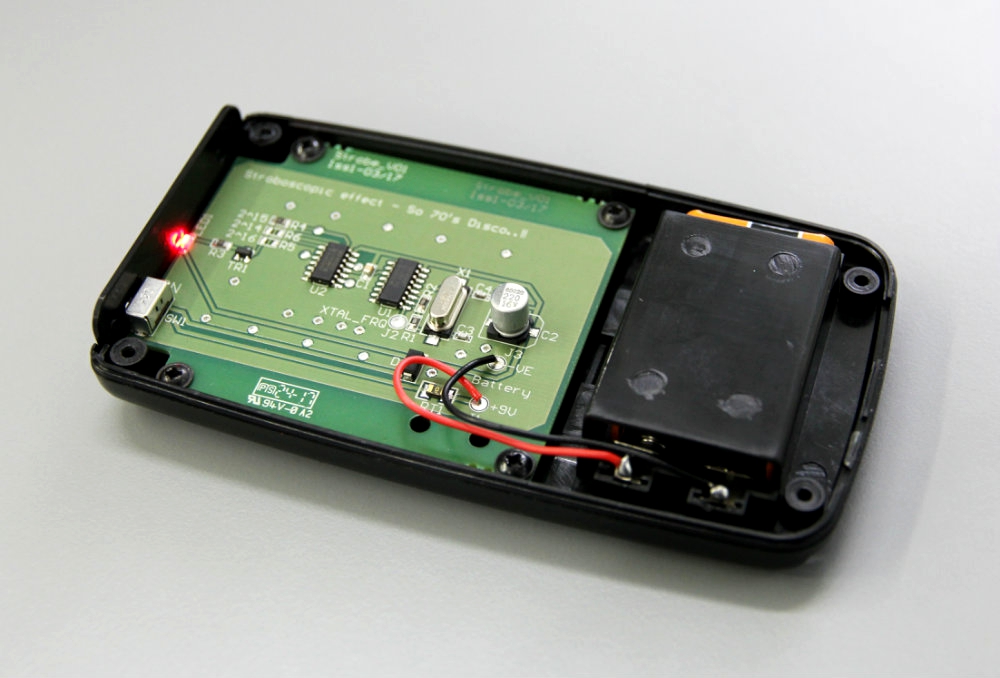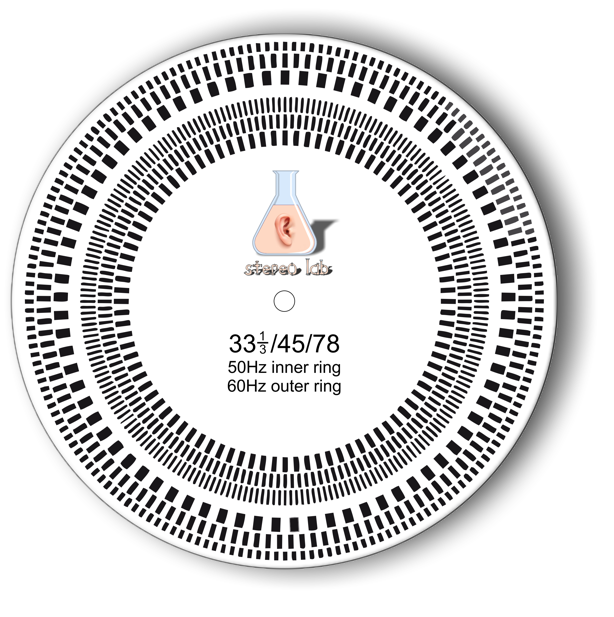| Nominal speed | 50Hz region | Strobe (50Hz) | 60Hz region | Strobe (60Hz) |
|---|---|---|---|---|
| 33⅓ RPM | 33⅓ RPM | 180 lines | 33⅓ RPM | 216 lines |
| 45 RPM | 45.11 RPM | 133 lines | 45.00 RPM | 160 lines |
| 78 RPM | 77.92 RPM | 77 lines | 78.26 RPM | 92 lines |
Stroboscope disc
A stroboscope disc is a paper, cardboard or plastic disc with a spindle hole in the centre which may be placed on the turntable like a record to measure the turntable's rotational speed. When illuminated with alternating current lighting, the pattern of bars on the stroboscope disc appears stationary when the turntable speed matches the standard speed³.
In order that the pattern appears stationary, the lines have to advance exactly by one space between the repetitive pulses of the alternating current light4. The number of lines required to fulfil this criteria is also specified in IEC 60098:1987 and the numbers are given in Table. 1.
Click on the stroboscope disc image to download a .pdf file of a stroboscope. Cut round the perimeter circle and make a 7mm hole in the centre. This may be employed to check turntable speed as described above.
Notes and references
1. Available from the International Electrotechnical Commission webstore.
2. Motor speeds were standardised in the pre-LP era. In 60 Hz regions a two-pole, AC synchronous motor running at 3600 RPM geared down by a 46:1 ratio will produce 78.26 RPM. In regions that use 50 Hz current, the standard 77.92 RPM is derived from a two-pole, 3000 RPM motor and a 77:2 ratio. The advantage of 33⅓ RPM is that it divides exactly into 3000 and 3600, so the speed is precise in regions which have either a 50Hz or a 60Hz AC supply. The note on this page discusses the stability of the mains AC supply frequency.
3. It's not difficult to calculate the number of lines required on the stroboscope disc. Take the example of 33⅓ RPM record illuminated by a light fed by 50Hz AC power. A record turning at 33⅓ speed turns 33.333⁄60 × 360° = 200°/sec. For the pattern to appear stationary, we need an advance of 1 line per pulsation of the light source.
 Remember that a normal electric light pulsates twice in one cycle of AC power; once on the positive half-cycle, and once on the negative. So a light on 50Hz AC power is a light-source pulsating at 100Hz. Thus we need 200°⁄100 = 2° between the lines on the disc, or 180 lines in a 360° circle.
Remember that a normal electric light pulsates twice in one cycle of AC power; once on the positive half-cycle, and once on the negative. So a light on 50Hz AC power is a light-source pulsating at 100Hz. Thus we need 200°⁄100 = 2° between the lines on the disc, or 180 lines in a 360° circle.
4. There is a caveat here. Because, both the light and the rotating magnetic field are derived from the same AC supply, illuminating a strobe disc does NOT give an indication of the true accuracy of the rotational speed; just that the relationship between the speed and the mains frequency is correct. The note on this page discusses the stability of the mains AC supply frequency.
Some manufacturers provide a battery powered crystal-derived 100Hz stroboscope. These units use a high-frequency crystal oscillator divided by chains of flip-flops so that a bright LED can be flashed at 100Hz (or 120Hz). The internals of one such unit due to REGA is illustrated. The crystal, divider-chain, driver transistor and flashing LED light-source are easily distinguished in the photograph. A unit such as this, enables a true speed check to be made using a strobe disc.
Links
 Pspatial Audio Home page
Pspatial Audio Home page
For all support issues, go here.
For Pspatial Audio sales, email: sales@pspatialaudio.com

© Pspatial Audio 2020. All rights reserved.
